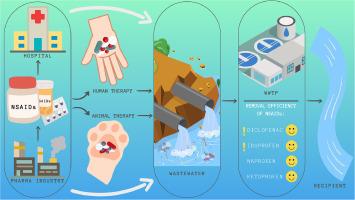The ability of UWWTP to remove NSAIDs: Impact on water quality in the Odra River Czech Republic concerning incoming European legislation
IF 5.4
Q2 ENGINEERING, ENVIRONMENTAL
引用次数: 0
Abstract
Increased consumption of pharmaceuticals has resulted in their detection in wastewater. If wastewater treatment plants (WWTPs) fail to eliminate these substances adequately, they can seep into the environment, posing potential risks. As non-steroidal anti-inflammatory drugs (NSAIDs) belong to the pharmaceuticals most frequently examined in wastewater, this study aimed to monitor wastewater from the municipal wastewater treatment plant in Ostrava (UWWTP) over the course of a year, specifically assessing how the presence of these substances in discharged wastewater could contaminate the Odra River. To further understand the impact of NSAIDs, we evaluated the effectiveness of UWWTP technology in removing the following selected drugs: diclofenac (DCF), ibuprofen (IBU), naproxen (NAP) and ketoprofen (KET) - as well as their main metabolites: 4′-hydroxydiclofenac (hydroxyDCF), carboxyibuprofen (carboxyIBU), desmethylnaproxen (desmethylNAP), and ketoprofen glucuronide (glucuronideKET).
Wastewater samples were collected at both the inflow and outflow of the urban wastewater treatment plant (UWWTP) Ostrava from October 2022 to September 2023. The analysis was performed using liquid chromatography coupled with tandem mass spectrometry (LC-MS/MS). The concentrations of the monitored substances at the UWWTP inflow varied significantly, ranging from 79 ng/L to 112,125 ng/L, with the highest levels detected for ibuprofen (IBU), diclofenac (DCF), and their metabolites. The UWWTP demonstrated impressive treatment efficiency for IBU, exceeding 98%, while for DCF, it ranged between 56% and 87%. Building on these findings, a monitoring campaign was initiated along the Odra River to evaluate the concentrations of IBU and DCF - substances that had not been measured before. Water samples were taken from various locations along the Odra River from October to November 2023 and analyzed using the same methodology as the wastewater samples. The results indicate that, in line with the proposed environmental quality standards (EQS), IBU and DCF do not pose a significant contamination risk to the Odra River.

UWWTP 去除非甾体抗炎药的能力:对捷克共和国奥德拉河水质的影响,涉及即将出台的欧洲立法
药品消费量的增加导致在废水中检测到这些物质。如果废水处理厂(WWTP)不能充分消除这些物质,它们就会渗入环境,造成潜在风险。由于非甾体抗炎药(NSAIDs)属于废水中最常检测到的药物,因此本研究旨在对俄斯特拉发市污水处理厂(UWWTP)一年来的废水进行监测,特别是评估排放废水中存在的这些物质会如何污染奥德拉河。为了进一步了解非甾体抗炎药的影响,我们评估了 UWWTP 技术在去除以下选定药物方面的效果:双氯芬酸 (DCF)、布洛芬 (IBU)、萘普生 (NAP) 和酮洛芬 (KET) 及其主要代谢物:4′-hydroxydiclofenac (hydroxyDCF)、carboxyibuprofen (carboxyIBU)、desmethylnaproxen (desmethylNAP) 和 ketoprofen glucuronide (glucuronideKET)。2022 年 10 月至 2023 年 9 月期间,在俄斯特拉发城市污水处理厂(UWWTP)的入水口和出水口采集了废水样本。分析采用液相色谱-串联质谱法(LC-MS/MS)进行。西乌克兰城市污水处理厂进水口的监测物质浓度变化很大,从 79 纳克/升到 112,125 纳克/升不等,其中布洛芬 (IBU)、双氯芬酸 (DCF) 及其代谢物的浓度最高。西湖污水处理厂对 IBU 的处理效率非常高,超过 98%,而对 DCF 的处理效率则在 56% 至 87% 之间。在这些研究结果的基础上,奥德拉河沿岸启动了一项监测活动,以评估 IBU 和 DCF 的浓度--这些物质以前从未测量过。2023 年 10 月至 11 月,在奥德拉河沿岸的不同地点采集了水样,并采用与废水样本相同的方法进行分析。结果表明,根据拟议的环境质量标准 (EQS),IBU 和 DCF 不会对奥德拉河造成重大污染风险。
本文章由计算机程序翻译,如有差异,请以英文原文为准。
求助全文
约1分钟内获得全文
求助全文
来源期刊

Journal of hazardous materials advances
Environmental Engineering
CiteScore
4.80
自引率
0.00%
发文量
0
审稿时长
50 days
 求助内容:
求助内容: 应助结果提醒方式:
应助结果提醒方式:


